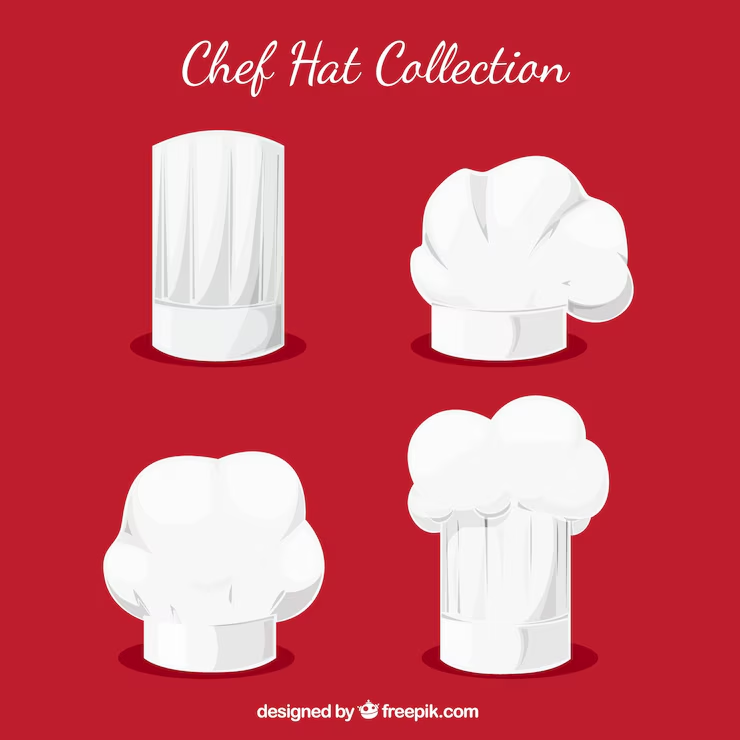Introduction
The History Behind the Iconic Chefs Hat
The Chefs hat, also known as the toque blanche, has a rich history dating back centuries. Originating in the kitchens of France during the 16th century, it served both practical and symbolic purposes. The height of the hat was said to signify the Chefs level of experience and expertise, with taller hats reserved for more seasoned professionals.
Evolution of the Chefs Hat: From Functionality to Symbolism
Initially designed for practical reasons such as keeping hair out of food and providing ventilation in hot kitchens, the Chefs hat evolved into a symbol of authority and professionalism. Over time, it became synonymous with the culinary arts and is now an iconic emblem recognized worldwide.
Importance of the Chefs Hat
Professionalism and Authority in the Kitchen
Wearing a Chefs hat is not merely a tradition; it signifies a commitment to professionalism in the culinary world. Chefs wear their hats with pride, signifying their dedication to the craft and their role as leaders in the kitchen.
Hygiene and Safety
Beyond its symbolic value, the Chefs hat serves practical purposes in maintaining hygiene and safety standards in the kitchen. By keeping hair contained and preventing it from falling into food, it helps ensure the cleanliness and integrity of dishes served to customers.
Types of Chefs Hats
Traditional Toques
The traditional Chefs hat, or toque, is characterized by its tall, pleated design. The number of pleats traditionally indicated the Chefs level of experience, with each pleat representing a specific culinary skill mastered.
Skull Caps
Skull caps, also known as Chefs caps or Chefs beanies, have become increasingly popular in modern kitchens. These close-fitting caps offer a more streamlined and contemporary alternative to traditional toques, while still providing the necessary functionality.
Beanies and Berets
In recent years, chefs have embraced more casual headwear options such as beanies and berets. While these may deviate from the traditional image of a Chefs hat, they offer chefs the opportunity to express their personal style while still adhering to basic hygiene standards.
The Significance of Height
Hierarchy in the Kitchen
The height of a Chefs hat has historically been associated with the Chefs level of expertise and authority in the kitchen. In traditional French kitchens, the head chef, or “chef de cuisine,” would typically wear the tallest hat, while sous chefs and commis chefs would wear shorter hats to denote their subordinate roles.
Symbolism of Achievement
For aspiring chefs, earning the right to wear a taller hat is a significant milestone in their culinary careers. It represents years of hard work, dedication, and skill development, culminating in the recognition of their expertise by their peers and mentors.
Materials and Construction
Traditional Fabrics
Traditional Chefs hats were typically made from starched cotton or linen, which gave them their distinctive crisp, white appearance. These fabrics were chosen for their breathability and ability to withstand high temperatures in the kitchen.
Modern Innovations
Today, Chefs hats are available in a variety of materials, including lightweight and breathable fabrics such as polyester and blends. Modern innovations in fabric technology have resulted in hats that are more comfortable to wear for extended periods, without sacrificing their functionality or aesthetic appeal.
Cultural Variations
French Influence
The French have long been associated with culinary excellence, and their influence extends to the design and symbolism of the Chefs hat. The traditional toque blanche remains a ubiquitous symbol of French gastronomy and is worn with pride by chefs around the world.
International Adaptations
While the classic French Chefs hat remains the most recognizable symbol of culinary expertise, variations can be found in kitchens worldwide. Different cultures have adapted the design and symbolism of the Chefs hat to reflect their own culinary traditions and customs.
The Psychology Behind the Chefs Hat
Boosting Confidence
Wearing a Chefs hat can have a psychological impact on both the wearer and those around them. For chefs, donning the hat can instill a sense of confidence and authority, while customers may feel reassured by the sight of a chef wearing traditional attire.
Creating a Sense of Identity
The Chefs hat is more than just a piece of clothing; it’s a symbol of identity and belonging within the culinary community. Chefs often take pride in their hats, customizing them with badges, pins, or embroidery to reflect their personal style and achievements.
Famous Chefs Hats Throughout History
Iconic Chefs and Their Signature Styles
Throughout history, certain chefs have become synonymous with their distinctive hats. From the towering toques of Auguste Escoffier to the colorful bandanas of Emeril Lagasse, these iconic hats have become part of the Chefs legacy.
Memorable Moments in Culinary Fashion
Over the years, the Chefs hat has made appearances in popular culture, from movies and television shows to advertising campaigns and fashion runways. Its timeless appeal and association with culinary excellence continue to captivate audiences worldwide.
The Chefs Hat in Popular Culture
Representations in Media
The Chefs hat has been depicted in various forms of media, often as a symbol of culinary expertise and authority. Whether portrayed in films, cartoons, or advertisements, it remains a recognizable icon of the culinary world.
Merchandising and Branding
The popularity of cooking shows and celebrity chefs has led to a surge in chef-themed merchandise, including hats, aprons, and other apparel. These items allow fans to channel their inner chef and express their passion for cooking in style.
Modern Trends
Customization and Personalization
In today’s culinary landscape, chefs are increasingly embracing customization and personalization when it comes to their attire. From embroidered logos to bespoke designs, chefs are finding creative ways to make their hats uniquely their own.
Fashion vs. Functionality
While traditional Chefs hats will always hold a special place in culinary tradition, modern chefs are also exploring alternative headwear options that prioritize comfort and functionality. Whether it’s a stylish beanie or a practical skull cap, chefs are redefining what it means to look the part in the kitchen.
Challenges and Controversies
Gender Bias
Historically, the culinary profession has been male-dominated, and the traditional Chefs hat has been seen as a symbol of masculinity. However, as more women enter the industry, there is a growing movement to challenge gender norms and promote inclusivity in kitchen attire.
Accessibility and Inclusivity
While the Chefs hat has long been a revered symbol of culinary excellence, it can also be a barrier for those with different cultural or religious beliefs. Some chefs may feel uncomfortable wearing traditional headwear, leading to calls for greater flexibility and inclusivity in kitchen dress codes.
Maintaining the Prestige
Adapting to Changing Times
As the culinary landscape continues to evolve, chefs must balance tradition with innovation to stay relevant. While the Chefs hat remains a cherished symbol of culinary tradition, it’s essential to adapt to changing times and embrace new trends and technologies.
Preserving Tradition
Despite the challenges of modernization, many chefs remain committed to preserving the time-honored traditions of their craft, including the wearing of traditional attire. By upholding these traditions, chefs pay homage to the rich history and heritage of the culinary profession.
The Future of the Chefs Hat
Innovations in Design
As technology advances and culinary trends shift, we can expect to see further innovations in the design and construction of Chefs hats. From sustainable materials to ergonomic designs, the Chefs hat of the future will continue to evolve to meet the needs of chefs in the 21st century.
Cultural Relevance in a Globalized World
In an increasingly globalized world, the Chefs hat serves as a symbol of cultural exchange and collaboration. As chefs draw inspiration from diverse culinary traditions, the hat remains a universal symbol of excellence that transcends borders and unites chefs from around the world.
Conclusion
In conclusion, the Chefs hat is much more than a piece of clothing. It’s a symbol of culinary excellence, tradition, and identity. While its design and significance may evolve over time. Its enduring appeal as a marker of professionalism and authority in the kitchen will continue to endure for generations to come.
FAQs
What is the significance of the tall, pleated design of traditional Chefs hats?
The tall, pleated design of traditional Chefs hats, also known as toques, has historical significance. Each pleat is said to represent a specific culinary skill mastered by the chef, with taller hats denoting higher levels of expertise.
Do all chefs wear traditional tall hats, or are there alternatives?
While traditional tall hats remain popular in many kitchens, modern chefs have embraced alternatives such as skull caps, beanies, and berets. These options offer chefs greater flexibility and comfort while still maintaining basic hygiene standards.
Why do some chefs customize their hats with badges or embroidery?
Many chefs choose to personalize their hats with badges, pins, or embroidery to reflect their personal style and achievements. It’s a way for chefs to express their individuality and showcase their accomplishments in the culinary world.
Are there any cultural or religious considerations regarding the wearing of Chefs hats?
In some cultures or religions, wearing certain types of headwear may conflict with personal beliefs or traditions. As a result. There is a growing movement within the culinary industry to promote inclusivity and flexibility in kitchen dress codes.
What is the future of Chefs hats in the culinary world?
As culinary trends evolve and technology advances. We can expect to see further innovations in the design and construction of Chefs hats. However, the enduring appeal of these hats as symbols of professionalism and tradition is likely to remain unchanged.







